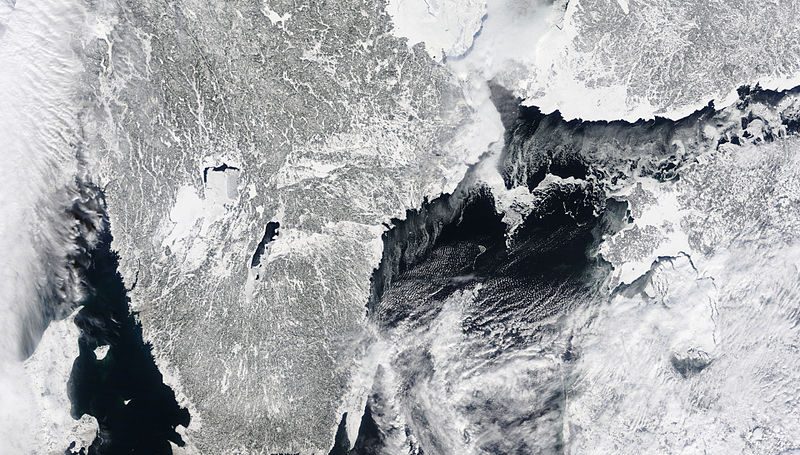
Netflix’s newest dystopian drama is The Rain, a near-future tale of a cataclysmic plague unleashed on southern Scandinavia by a malevolent corporation called Apollon, which aims to (profitably) provide the ‘cure’ the disease they have (secretly) manufactured. Reflecting the success of Nordic noir on the platform (including series such as Bordertown, Occupied, and Trapped), as well as the runaway success of The Bridge on competitor Hulu, Netflix has chosen to make this series its first production in the region. While The Rain is highly derivative – evincing elements of The Walking Dead, The 100, and Fortitude – it is quite bingeable. This is in part due to solid acting from some well-known Danish television stars, including Lucas Lynggaard Tønnesen (Department Q), Lars Simonsen (The Bridge), and Iben Hjejle (Dicte).
The Rain follows closely on the heels of Netflix’s first German-language production, Dark, a mind-bending, time-traveling thriller that has drawn comparisons with Stranger Things given its eerie aesthetics and tapping of the 1980s-era paranoia with the government. Both series have made me reconsider the claim that I made in my recent article on IR-inflected television in Geopolitics, namely that ‘European production companies have proved somewhat reticent to combine the fantastical with the geopolitical’ (other than Occupied, which depicts a ‘velvet glove’ invasion of Norway by Russia to secure access to its petroleum exports). While I continue to stand by this, Netflix’s increasing presence in a market hitherto dominated by national broadcasters like DR, ZDG, and SVT is likely to prompt these companies to consider the leap into speculative realm. And given the current state of geopolitics in Norden, we are likely to see an increasingly bleak view of what is to come.
Spoiler Alert: The Rain opens with an able, yet shy Simone Andersen (Alba August) prepping for an exam when her scientist father scoops her up from high school in a desperate attempt to escape a coming rain storm. Failing to make it to safety, he leads his wife and two children into a hidden bunker supplied with food and protected from the ‘rain’, which is carries a virus that infects and later kills those it touches. Simone’s father leaves the bunker for mysterious reasons and her mother dies in the rain, leaving her to care for her adolescent brother. Fast-forward six years: Simone and her brother join a motley band of survivors as they make their way from Zealand to the northern part of the Scandinavian Peninsula, which is cordoned off by a wall that stretches from the Baltic to the North Sea (one assumes there is southerly wall across the narrow neck of Jutland). As they head into Copenhagen and eventually to Scania, they are pursued by the ‘Strangers’, seemingly-murderous paramilitaries who speak accented-English and deploy drones to find and capture any free-range Danes (these interlopers are – rather ominously – played by actors of Slavic, Caucasian, and Middle Eastern descent). Life is a constant battle against hunger, a vengeful environment, and foreigners with superior firepower.
Premièring on 4 May 2018, the series only slightly predated the Swedish Civil Contingencies Agency’s issuing of its newly-revised emergency handbook intended to prepare the populace for a war, climatic catastrophe, or other mass-fatality events. Entitled (in the English version) ‘If Crisis or War Comes’, Swedish authorities suggest that people stock up on tortillas, tinned hummus, and wet-wipes, among other everyday necessities. Sweden’s citizens are urged to focus on four areas of preparedness: food; water; warmth; and communication. As the New York Times points out, this iteration represents the first major revision since the midpoint of the Cold War and serves as a marker of a new era of insecurity for the notoriously peaceful nation. In recent years, Stockholm has reinstated conscription (including women in this go-around) and publicly wavered on its long-held commitment to neutrality, openly considering joining NATO to mitigate increasing threats from Russia (first and foremost), but also other quarters in a world beset by the proliferation of WMDs, jihadi and right-wing terrorism, politicised hacking and fake news, and looming environmental dangers.
While Sweden has not opted to follow the United States’ Centre for Disease Control’s full-on descent into popular culture via its well-publicised (and often parodied) ‘zombie preparedness’ campaigns, the timing of the brochure’s release can easily be conflated with the effects of many Scandinavians watching The Rain and wondering ‘what if…’. This is especially true if – after wrapping up a binge session – they click on Netflix’s recommendation and watch the second series of Occupied. Going live back in March, the follow-up to the powerful first season depicts a deepening crisis across Nordic Europe, which ultimately draws in Finland and eastern European countries into Russia’s geopolitical web. As U.S. President Donald Trump seeks to undermine his country’s NATO obligations and upset the balance of European-Iranian relations just as Vladimir Putin settles into a new term, perhaps it is time for the people of northern Europe to prepare for the unknown.
Further Reading on E-International Relations
- Popular Culture Matters: An Introduction
- Third Cinema and Social Science
- Cold War Heritage in Sweden: Pastime Threats, Cosy Cavers and Gendered Nostalgia
- Identity and Foreign Policy: Competing Narratives in Swedish State Autobiographies
- Security as Nation Branding: Sweden’s Status-Seeking Strategy
- Doom, Boom or Hibernation? Covid-19 and the Defense Industry